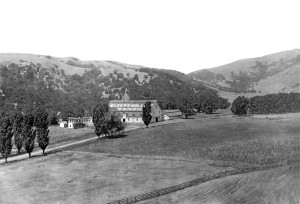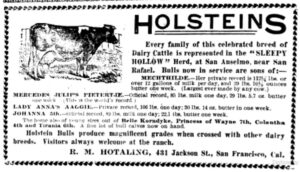
Sleepy Hollow Ranch, ca. 1910
San Francisco whiskey dealer Anson P. Hotaling purchased the Sleepy Hollow valley property in 1887. His bachelor son, Richard, built an elegant country home at the upper end of the valley in 1900. The dairy in the valley had been under lease, and Richard Hotaling decided to operate it himself. He enlarged and modernized the barns and silos, hired a dairy manager, and imported a herd of Holstein cattle from Holland. He named the ranch Sleepy Hollow, and his prize-winning bull was called Legend of Sleepy Hollow. The following description of the ranch by Richard Hotaling appeared in the Pacific Rural Press, April 30, 1904.
Sleepy Hollow Ranch
In Marin county, Cal., less than an hour’s trip from San Francisco, on the line of the North Shore railroad, is the station San Anselmo, and 3 miles from there is the Sleepy Hollow ranch of which the owner, Mr. R. M. Hotaling, prepares the following description for the Holstein-Friesian Register.
“The location is unique. For more than a mile the road leads through a narrow pass which gradually widens into a number of broad valleys completely hemmed in by high hills, so that the whole place of 1600 acres in a general way is like a gigantic amphitheater.
The highest point is over 1000 feet above the floor of the valley. The hills in places are very steep and overgrown by patches of numerous small oak, laurel and madrona trees. The natural pasturage grasses of burr clover and alfilaree are abundant and grazing is excellent to the remotest limits of the uplands. The shrubs and underbrush afford browsing during certain months, so that unless overstocked, the “dry range” will support the young and fallow herd without additional feed throughout the entire year.
The hills abound in unfailing springs which have been developed and piped into large redwood tanks. A shortage of water is never known. There is not enough for extensive irrigation, but a plan is already in contemplation for constructing large reservoirs to conserve the rain drainage from the hills. About 400 acres of the fertile valley land could be brought thus to its greatest production and during the summer months would yield green feed and roots.
The milking barns are in three separate buildings accommodating sixty cows each; thirty on a side with a wide feeding space between them. The hay and grain are stored in a wing of the horse barn and are carried into the milking barns on a movable bin which operate on rails laid into the cement floor.
Our climate is never severe enough to compel us to shelter our cows, so they are in the barns only long enough for milking and feeding. They are fastened in wooden stanchions and stand on a wooden platform over cement. We are now milking eighty cows. When the original herd came here there were but fifty head all told.
Marin county has always been a great place for the Jersey cattle, and when my herd of Holsteins was driven through the town of San Rafael it was predicted by the wiseacres and village oracles, that while they were fine large cattle and gave a lot of milk, they would never do for these hills. This next October it will be five years that we are here. The cows climb the highest hills and seem the healthier and more vigorous for the exercise.
 Another point in favor of the Holsteins in the hills is that by reason of their gentle and sensible dispositions, they do not take fright at the sight of a pedestrian or anything that seems unusual and go plunging pell mell down the hillsides, injuring both themselves and the pasturage, as is the case with the Jersey. There is not a cow or calf in my herd that I cannot approach in the pasturage. It is true that we have considerable trouble with our hired men employed as milkers and calf feeders, for they seldom stay after they have saved a little money; but in spite of these unfortunately frequent changes we try to use the greatest patience and I might say courtesy with our cows from earliest calfhood. They know they have nothing to fear. To the original herd of fifty I have added by purchases in the Eastern and Middle Western States, which together with the calves I have raised, has increased the herd to its present number of over 200. I have sold a great many cows and calves. I am continually raising my standard of excellence and gradually I shall achieve my aim in having none but the best.”
Another point in favor of the Holsteins in the hills is that by reason of their gentle and sensible dispositions, they do not take fright at the sight of a pedestrian or anything that seems unusual and go plunging pell mell down the hillsides, injuring both themselves and the pasturage, as is the case with the Jersey. There is not a cow or calf in my herd that I cannot approach in the pasturage. It is true that we have considerable trouble with our hired men employed as milkers and calf feeders, for they seldom stay after they have saved a little money; but in spite of these unfortunately frequent changes we try to use the greatest patience and I might say courtesy with our cows from earliest calfhood. They know they have nothing to fear. To the original herd of fifty I have added by purchases in the Eastern and Middle Western States, which together with the calves I have raised, has increased the herd to its present number of over 200. I have sold a great many cows and calves. I am continually raising my standard of excellence and gradually I shall achieve my aim in having none but the best.”

